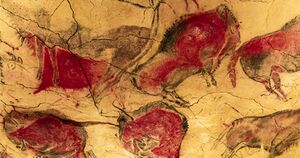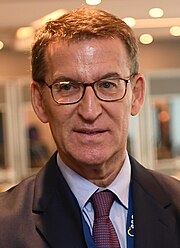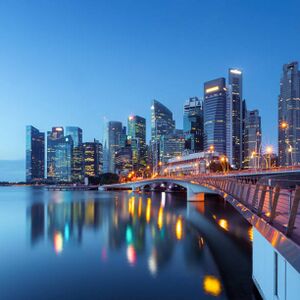Galicianna
Kingdom of Galicianna Raiñado de Galicianna | |
|---|---|
| Motto: Aquí está o misterio que firmemente profesamos ("Here is the mystery that we firmly profess") | |
| Anthem: Rumorosos, que dixeran | |
| Capital | Monteaño |
| Official languages |
|
| Ethnic groups |
|
| Religion |
|
| Demonym(s) | Galianan |
| Government | Unitary Parliamentary Monarchy |
• King | Xacobo II de Beariz |
• Prime Minister | Lois Mondariz |
• President of the Government | Xaquín Pau |
| Legislature | National Assembly of Parliamentary Representation |
| Senate | |
| Parliamentary Chamber of Representatives | |
| Unification of the Duchies | |
• Foundation of the Nation | 1065 |
• Creation of the Constitutional Monarchy | May 14th, 1876 |
| Population | |
• January 2023 estimate | 122,590,878 |
| GDP (PPP) | 2023 estimate |
• Total | $3,312,405,523,560 |
• Per capita | $27,020 |
| GDP (nominal) | 2023 estimate |
• Total | $2,077,915,382,100 |
• Per capita | $16,950 |
| Gini (2023) | medium |
| HDI (2020) | very high |
| Currency | Ameixas (AMX) |
| Driving side | right |
| Calling code | +341 |
| Internet TLD | .gal |
Galicianna, officially the Kingdom of Galicianna is a parliamentary monarchy, composed of 13 duchies, 1 maritime county, a suburban region and a capital district. Its capital city, Monteaño, is home to the country's key political, judicial, and financial institutions. The country is situated in two continents: Thrismari and Thuadia . Galicianna is bordered by Vileria to the north-west, Amilagro to the south-west and Gholetia to the south.
The population of approximately 122 million people lives concentrated in the coastal areas of the country, making up more than 60% of the total population. The three most populated cities in the country are located in these areas, being Monteaño (the capital), Mazá and Amoroga.
Being a very ancient nation (having been founded at the beginning of the 11th century), it was a fairly isolated nation for many centuries, having a very homogeneous ethnic, cultural and religious composition. The country remained closed and isolated until the mid-20th century, when policies of opening and incorporation into the international market began to be promoted. These would begin to be applied more strongly in the 1970s, and the country would experience rapid industrialization, economic growth and urbanization.
Currently, Galicianna is considered a developing country. Despite having a human development index considered "very high" and having a relatively high GDP per capita, the country suffers from high inequality and a lack of a welfare state. However, inequality has been gradually falling over the last ten years and more public services have been created. Galicianna is expected to become a developed country in the next 20 years.
The country's economy is based mainly on the tertiary sector, with a large participation of the secondary sector. The industry represents 37% of the country's GDP, the main ones being electronics, agri-food and oil. The country also has a developed financial system, with important banking entities. Agriculture barely represents 3% of the nation's GDP, highlighting winegrowing and the cultivation of tropical fruits such as pineapple, mangoes and bananas.
Galicianna scores fairly well on measures of democracy and political freedom, being considered a "deficient democracy". However, it has poor scores in statistics such as press freedom, corruption index or respect for the environment.
Etymology
The etymology of the country's name comes from "Galaican", the primitive people who inhabited the territory. After the influence of the Romance peoples, it ended up with the name Galicianna, which means "Land of the Galaican".
Language
The most spoken language in the country is Galician, coming from Vulgar Latin. In addition, there are also certain social minorities who speak Spanish, Catalan and French. All the languages spoken in the territory have in common being Romance.
History
The history of the country's territory dates back to Prehistory, thousands of years before the nation as such existed.
Originally, the nation was inhabited by a primitive people called "Garaxus". These were nomadic hunter-gatherer tribes, who had been living in the country for millennia. This is known due to the discovery of cave paintings, which represented animal hunting scenes, or burial places. The Garaxus did not have any writing system. They did not master iron or bronze, and most of their tools and weapons were made of wood and polished stone. Conflicts between tribes over resources were common, and this was dated in paintings.
These nomadic tribes did not have contact with other peoples until the 20th century BC, with the arrival of the Galician peoples. Those who arrived were part of a rebellion of Germanic peoples, who had been expelled from their nation and were looking for another territory to settle.
Upon arriving in Galicianna, they decided to stay there due to the fertility of its lands and the good climate there. His relationship with the native peoples was quite peaceful. They lived each on their own. The Galicians founded small walled towns called "castros".
They were much more advanced than the Garaxus, having extensive knowledge about mining, goldsmithing, livestock and agriculture; developing cultivation systems. The nomadic tribes, little by little, were being assimilated by the Galician peoples. Seeing that they could have a more stable and comfortable life in the towns, they moved there. Thus, slowly, the last nomadic peoples became extinct; until completely disappearing around the 5th century BC.
During these times, the first writing system was developed. This consisted of 15 symbols, which were combined to form sentences and concepts. The writings were usually collected on stone tablets, and were engraved by rubbing a piece of hot iron with the stone. It was often accompanied by graphic drawings to facilitate understanding for illiterate people. The religion was polytheistic, worshiping numerous Germanic gods such as Loki or Odin.
Around the 5th century BC, the first Roman people arrived in Galicianna. These came from the surrounding territories and other continents, in search of fertile lands and places from which to obtain resources. Their arrival was violent, unlike that of the Galicians. The Roman people wanted to dominate the Galicians, and establish their own culture and religion. The latter opposed, and there were numerous wars between the two. Finally, in the year 875, after more than four centuries of disputes, the Roman people managed to establish their mandate.
With them, society changed radically. There was a strong social hierarchy, establishing classes and slavery existing (for the first time). The writing system was changed to Latin, adopting the letters that are known today. Most of the Galician towns were abandoned, and the first Romanesque cities were created. "Montecaprino" stands out, the predecessor city of Monteaño (the capital of Galicianna). Cities were much more orderly, laid out in a grid and planned. Running water systems were created that allowed exponential growth in agriculture and livestock.
The Romanesque towns expanded rapidly, forming the current country and baptizing it with the name of Galicianna. Routes were created between the different cities, facilitating commercial exchange and promoting economic development. Until the 11th century AD, Galicianna was one of the most prosperous territories in Anteria, and received much immigration from other places.
All this would change in the year 1035, when the Garmans arrived in Galicianna. Roman society was in decline, as they had neglected their army and there was increasing political instability. The Garmans took advantage of this opportunity, and conquered the territory of Galicianna without much opposition. They assassinated the main political leaders, and established a kingdom.
It is worth highlighting the introduction of Catholic Christianity into society. Religious teachings were strongly instilled, changing in a few decades to a strongly Christian society.
NOT FINISHED
Geography
Islands
Mountains and rivers
Climate
Fauna and flora
Territorial Organization
Grand Duchies
Counties
Government
Galiciana is a Unitary Parliamentary Monarchy, in which the king is the head of state of the nation. The headquarters of the government is located in Monteaño, the capital of the country; in addition to other institutions. The right to vote is reserved for all citizens over 18 years of age who are not serving a prison sentence, regardless of sex, race, sexual orientation or religion.
The country's government is divided into three different branches of government.
Legislative
The legislative branch is bicameral, consisting of two institutions: the National Assembly of Parliamentary Representation and the Royal Senate.
The National Assembly represents all voters. Having 485 members, they are voted every 4 years. Members must belong to a specific political party, and voters choose a list of the party they wish to represent them. In order to be represented in the Assembly, political parties must have a minimum of 5% of the total votes. If this percentage is not reached, the votes are counted as blank votes. The National Assembly is responsible for electing the Prime Minister by vote. If a prime minister is not elected within a period of 6 months, the elections are repeated.
The Royal Senate is made up of 225 members. 22 of them are chosen by royal appointment, being selected directly by the king. 78 are elected by regional governments based on their population (that is, the number of members each region appoints depends on the percentage of the total population of the country it represents). The other 125 are elected by universal suffrage by voting for political party lists, which must obtain at least 15% of the votes to be able to access the Senate.
The National Assembly is the most important institution of the legislative branch. It is responsible for approving and denying the laws proposed by the President of the Government. To pass a law, a simple majority must be obtained. If approved, the law goes to the Senate, where it is put to a second vote. If approved, it is approved directly. If not, the law is voted on again in the National Assembly (where it will be approved directly if it obtains enough positive votes, without having to go through the Senate again).
Executive
The executive branch is represented by the President of the Government and his ministers. The president is elected every 4 years (at the same time as legislative votes) by universal suffrage. In order to be president of the government, the candidate must also be elected as a member of the National Assembly. The executive branch is responsible for applying the laws approved by the legislative branch, in addition to having the ability to issue temporary decrees.
In the event of a national emergency such as a natural disaster, war, etc., the executive branch has the capacity to issue laws directly, without the need for them to go through the National Assembly. The state of national emergency can only be maintained for a maximum of 1 year. When that time passes, the approval of the National Assembly will be needed to continue it. The Supreme Court has the capacity to end the national emergency in any case and whenever it considers it necessary.
It may seem surprising that there is a President of the Government and a Prime Minister at the same time in a Parliamentary Monarchy, but each one has a specific function. The President of the Government is more in charge of internal issues, while the Prime Minister, together with the king, has mainly representative and diplomatic functions.
Judicial
The judicial branch consists of the Supreme Court and the Regional Courts. The Supreme Court is made up of 25 members. The members are elected by the Senate, with the senators chosen by the king directly not having the right to vote. The two political parties with the most representation in the Senate will be in charge of electing the judges. These will be chosen proportionally to the senators that each one has. Once the Supreme Court is constituted, the judges belonging to it will elect the 10 representatives of each Regional Court.
The Supreme Court has the ability to appeal laws passed by parliament that are considered not to be within the legal framework. It is also considered the last court of appeal, being in charge of approving death sentences. It can deny any decision made by the Regional Courts, having the capacity to change it.
Military
Economy
Galicianna's economy is strongly based on the technological and financial sectors; having a strong manufacturing industry. Other notable industries are oil, agri-food, mining and automobiles.
Galicianna is considered a high-income developing market economy. Having a relatively high degree of economic freedom, the economy is dominated by large multinational companies based in the nation, which usually dominate a certain sector and are export-oriented. Currently, the government does not intervene practically in the market; owning few publicly owned companies and applying few regulations in the market.
However, this was not always like that. Until the mid-20th century, Galicianna was a poor country with an economy based on agriculture. It would not be until the late 1950s, when effective economic policies would begin to be applied, which would begin to make the country grow rapidly. This growth would be consolidated in the 1980s, a time in which average growth rates of 7% per year would be recorded. Until the end of the 20th century, the economy was tightly controlled; favoring local companies over foreign companies so that they could grow. When the country reached an industrial level that allowed it to compete in international markets, the economy began to gradually open; liberalizing economic sectors and facilitating foreign investments and the free market. The Galicianna model was similar to that of the so-called Asian tigers, being an economy based on the export of high value-added products and with a relatively small welfare state.
Among the nation's top exports (from highest to lowest) are electronic devices, microchips, semiconductors, bananas, refined petroleum, automobiles and steel. Galicianna is considered one of the world's largest exporters of electronic products, this sector representing 23% of the country's GDP.
Natural Resources and Produce
Demographics
Transportation and Infrastructure
Galiciana's infrastructure is made up of a large network of roads, airports and ports that connect the main cities of the country and cover the entire national territory. The country is located at a strategic point in the trade of the Delta Canton, since it controls one of the main entry routes for trade from the continents located to the east (Hiraethia, Caliandia, Olivacia and Meredonne).
The interurban transport network of Galicianna has a wide network of toll highways, which connect the most important cities in the country. The railway network does not have passenger service, and is mainly used for the transport of goods to ports, with trains reaching a maximum speed of 110 kilometers per hour. The country has always invested considerably more in highways than in rail transport, because these generate greater profitability and allow connecting more parts of the country. This is because the majority are privately owned and have tolls, which generate income and allow the network to continue improving and expanding through a system of concessions.
Air transportation is the most used way to transport people within the country. Because of how large the country is, it is the fastest way to get around. The main cities have airports with great capacity, being able to support more than 700 daily flights, both national and international.
Urban transportation is mainly based on the automobile. Galicianna has extensive urban highways, which connect the cities and allow a quick and efficient connection with the interurban network. However, the implementation of more public transportation in the last 20 years is also noteworthy. Three cities have metro systems, which connect the busiest points. In medium-sized cities, bus transportation predominates, but some also have trams or light rail. Despite all the efforts, 80% of trips in cities are still made by car, with a culture strongly rooted in the country's society.
Urban Transportation
Culture
Beliefs
Cuisine
National Symbols






